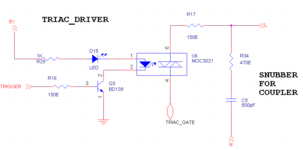vishweshgm
Member level 4
Hello,
I am trying to make a typical dimmer application (resistive heating coil 3.6kW (230V,16A)) using triac similar to the application shown below:

Instead of Hot and Neutral, I plan to use Red & Blue wires of three phase supply. I rigged this circuit in lab and triggerred triac at a point 'X' after a Zero cross pulse is generated (I dont know, technically ZCD is the right term, but the point where Red and Blue waveform intersect, I call it as ZCD point, as that is where I get a edge detection(yellow) on microcontroller)

So after every edge detection I control time at which triac is triggerred say that point X is between 0deg & 180deg. As I slowly move from 0 to 180 power delivery is decreasing which is exactly how I want to control. But I want your help to understand from theory point, what is happening here. It was easy for me to understand when there were only 2 lines Hot and neutral. But with this, I am unable to understand if this is right method and also if it is ok to drive triac like this.
Let me know if any more infor required.
I am trying to make a typical dimmer application (resistive heating coil 3.6kW (230V,16A)) using triac similar to the application shown below:
Instead of Hot and Neutral, I plan to use Red & Blue wires of three phase supply. I rigged this circuit in lab and triggerred triac at a point 'X' after a Zero cross pulse is generated (I dont know, technically ZCD is the right term, but the point where Red and Blue waveform intersect, I call it as ZCD point, as that is where I get a edge detection(yellow) on microcontroller)
So after every edge detection I control time at which triac is triggerred say that point X is between 0deg & 180deg. As I slowly move from 0 to 180 power delivery is decreasing which is exactly how I want to control. But I want your help to understand from theory point, what is happening here. It was easy for me to understand when there were only 2 lines Hot and neutral. But with this, I am unable to understand if this is right method and also if it is ok to drive triac like this.
Let me know if any more infor required.
